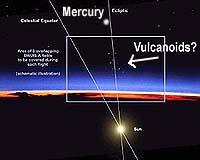
MESSENGER reaches its orbital perihelion today and passes within 0.31 astronomical units (AU) of the Sun (one AU is nearly 150 million kilometers or 93 million miles).
The mission's imaging team is taking advantage of the probe's proximity to the fiery sphere to continue their search for vulcanoids - small, rocky asteroids that have been postulated to circle the Sun in stable orbits inside the orbit of Mercury.
Vulcanoids are named after Vulcan, a planet once proposed to explain unusual motions in Mercury's orbit. Scientists have long suspected that these small, faint "space rocks" exist. There is a gravitationally stable region between the orbit of Mercury and the Sun, which means that any objects that originally formed there could have remained for billions of years and might still be there today.
All other such regions in the solar system are occupied by some type of debris (e.g., Trojan asteroids at stable points along the orbits of Jupiter and Neptune and Kuiper Belt objects near and beyond the orbit of Pluto).
The so-called vulcanoid region between the orbit of Mercury and the Sun is the main gravitationally stable region that is not known to be occupied. The region is, however, the most difficult to observe. Any vulcanoids would be difficult to detect from Earth because of the strong glare of the Sun. Previous vulcanoid searches have revealed no bodies larger than 60 kilometers in diameter.
But MESSENGER's travels in near-Mercury space enable a search for vulcanoids from a vantage never before attempted, says MESSENGER Science Team Member Clark Chapman, who is spearheading the team's search along with his associate, William Merline.
"With MESSENGER, we can search for vulcanoids as small as 15 kilometers across," said Chapman, a senior scientist at the Southwest Research Institute in Boulder, Colorado.
Between February 7 and 11, the wide-angle camera of MESSENGER's Mercury Dual Imaging System will have snapped 256 images in the areas east and west of the Sun. Because of the danger of the Sun's glare, the camera will have to peek just past the probe's sunshade to capture images.
"We are making the same observations on each day," MESSENGER team member Nancy Chabot explained. "This cadence will allow us to reject cosmic rays and to distinguish, by its motion, the class of each object imaged" (e.g., vulcanoid vs. near- or inner-Earth asteroid).
The team carried out a similar imaging campaign over a nine-day period in June 2008, capturing 240 images of the outer portions of the would-be vulcanoid belt. "This sequence was designed to refine our observing techniques, assess limiting magnitudes, verify detectability of known objects, and make an initial search,' Chapman explained.
"Vulcanoids, should they be found, may provide scientists with insights into the conditions prevalent in the early solar system," Chapman said.
"In particular, if they exist or once existed, they would represent an additional population of impactors that would have cratered no other planet but Mercury, implying that the geological processes on Mercury have happened more recently than we would calculate if we assumed that Mercury's craters formed at rates equivalent to cratering on the Moon and Mars."
If vulcanoids are found not to exist, then we could be more confident that most of Mercury's volcanic plains formed billions of years ago, as on the Moon, according to Chapman. The absence of vulcanoids would also focus scientists' thinking on why vulcanoids never formed or, if they did form, why they are no longer there.



Reader Comments
to our Newsletter